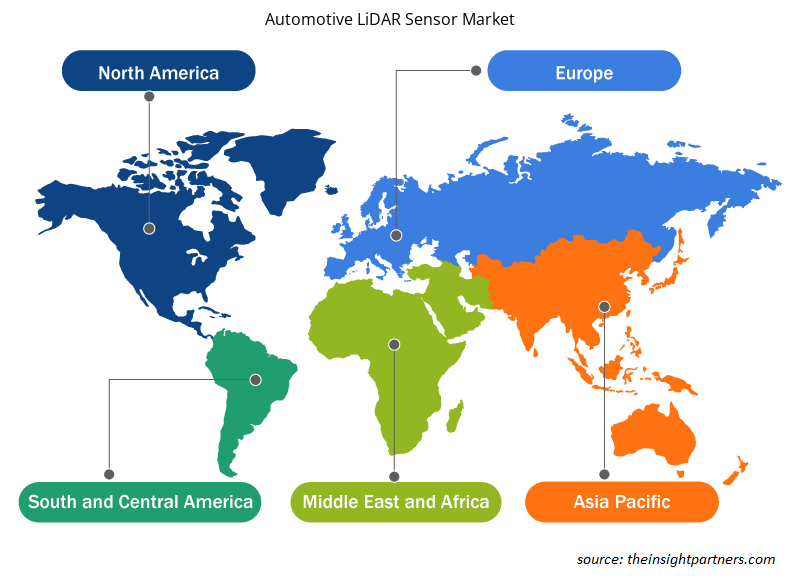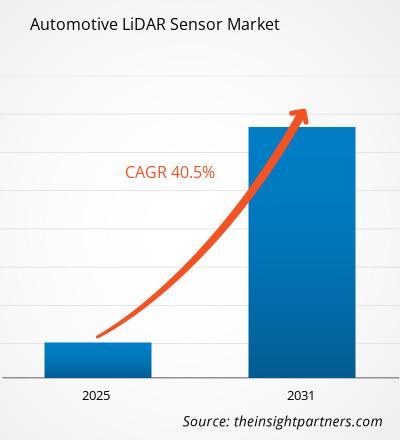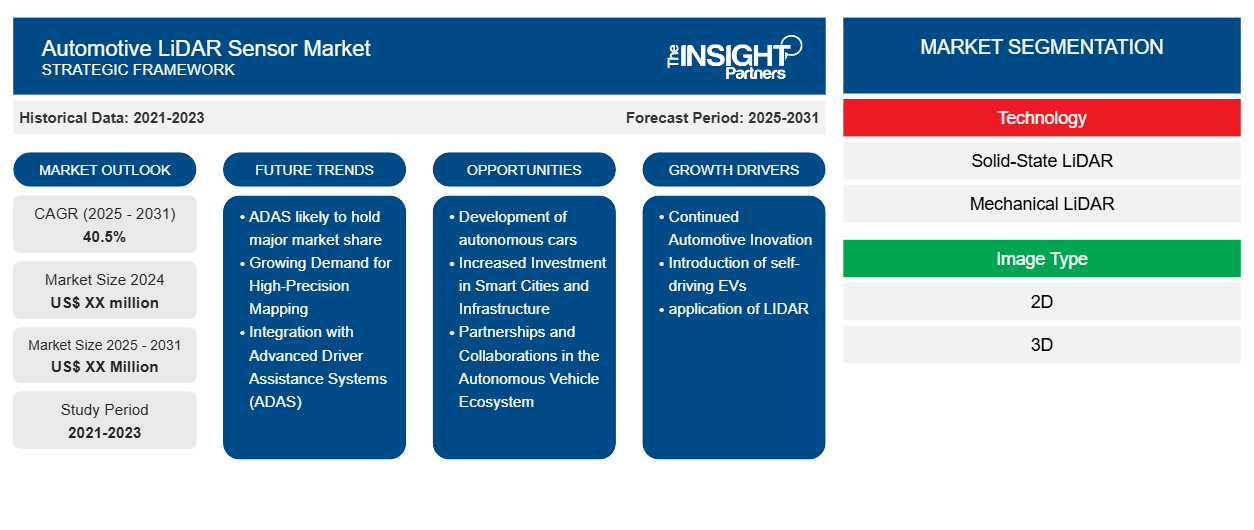Es wird erwartet, dass der Markt für LiDAR-Sensoren für Kraftfahrzeuge von 2023 bis 2031 eine durchschnittliche jährliche Wachstumsrate (CAGR) von 40,5 % verzeichnet, wobei die Marktgröße von XX Millionen US-Dollar im Jahr 2023 auf XX Millionen US-Dollar bis 2031 anwachsen wird.
Der Marktbericht zu LiDAR-Sensoren für Kraftfahrzeuge deckt wichtige Segmente wie Bildtyp, Anwendungen und Technologie ab. Marktdynamik, regionale Analyse und Wachstumsprognose von 2021 bis 2031 werden ebenfalls behandelt, zusammen mit einer Wettbewerbslandschaftsanalyse des Marktführers und seiner Innovationen, wobei lediglich die aktuellen Trends hervorgehoben werden, um den Beteiligten einen strategischen Vorteil in den Bereichen Investition und Entwicklung autonomer Fahrzeugtechnologien zu verschaffen.
Zweck des Berichts
Der Bericht Automotive LiDAR Sensor Market von The Insight Partners zielt darauf ab, die aktuelle Situation und das zukünftige Wachstum sowie die wichtigsten treibenden Faktoren, Herausforderungen und Chancen zu beschreiben. Dies wird verschiedenen Geschäftspartnern Einblicke geben, wie zum Beispiel:
- Technologieanbieter/-hersteller: Um die sich entwickelnde Marktdynamik zu verstehen und die potenziellen Wachstumschancen zu kennen, damit sie fundierte strategische Entscheidungen treffen können.
- Investoren: Durchführung einer umfassenden Trendanalyse hinsichtlich der Marktwachstumsrate, der finanziellen Marktprognosen und der Chancen entlang der Wertschöpfungskette.
- Regulierungsbehörden: Zur Regulierung von Richtlinien und Überwachungsaktivitäten auf dem Markt mit dem Ziel, Missbrauch zu minimieren, das Vertrauen der Anleger zu bewahren und die Integrität und Stabilität des Marktes aufrechtzuerhalten.
Automotive LiDAR-Sensor Marktsegmentierung
Technologie
- Festkörper-LiDAR
- Mechanisches LiDAR
Bildtyp
- 2D
- 3D
Anwendung
- Autonomes Fahrzeug
- Teilautonomes Fahrzeug
Fahrzeugtyp
- EIS
- HEV
- PHEV
- Batterieelektrisch
Fahrzeugtyp
- EIS
- HEV
- PHEV
- Batterieelektrisch
Passen Sie diesen Bericht Ihren Anforderungen an
Sie erhalten kostenlos individuelle Anpassungen an jedem Bericht, einschließlich Teilen dieses Berichts oder einer Analyse auf Länderebene, eines Excel-Datenpakets sowie tolle Angebote und Rabatte für Start-ups und Universitäten.
- Holen Sie sich die wichtigsten Markttrends aus diesem Bericht.Dieses KOSTENLOSE Beispiel umfasst eine Datenanalyse von Markttrends bis hin zu Schätzungen und Prognosen.
Wachstumstreiber auf dem Markt für LiDAR-Sensoren für Kraftfahrzeuge
- Kontinuierliche Innovationen im Automobilbereich: Die gesamte Automobilindustrie ist gespannt auf autonome Fahrzeuge und unterstützende Technologien. Automobilunternehmen sind innovativ, indem sie ADAS-Technologien mit einer größeren Vielfalt neuer und kostengünstiger Sensoren entwickeln. Um eine anpassungsfähige Fahrzeugsicherheitslösung bereitzustellen, dürfen sich ADAS-Systeme weniger auf rein visuelle und RADAR-basierte Systeme verlassen. Sie benötigen jedoch effizientere Systeme, um qualitativ hochwertigere Daten zur Unterstützung der Fahrer bereitzustellen.
- Einführung selbstfahrender Elektrofahrzeuge: Die neueste Anwendung von LiDAR wird durch den zunehmenden Trend in der Automobilindustrie vorangetrieben, der selbstfahrende (Drohnen) und Elektrofahrzeuge umfasst. Diese Autos verlassen sich stark auf LiDAR-Sensoren, um riesige 3D-Karten in alle Richtungen rund um das Fahrzeug zu erstellen, für eine bessere 360-Grad-Sicht und für genaue Informationen, die für die Selbstnavigation und Objekterkennung erforderlich sind.
- Anwendung von LIDAR: Die Einführung der LiDAR-Technologie sorgt dafür, dass Unternehmen wie Leddartech, Quantum Spatial, Geodigital, Topcon Positioning Systems, Innoviz Technologies und viele andere, die neue Geschäftsideen gefunden haben und täglich neue Innovationen hervorbringen, weiter wachsen werden. So kündigte der deutsche Autoteilehersteller Continental AG im vergangenen Jahr eine Investition in AEye an, einen Vorreiter in der Robotersicht- und Sensortechnologie, mit dem Ziel, sein LiDAR-Technologieportfolio zu erweitern.
Zukünftige Trends auf dem Markt für LiDAR-Sensoren für Kraftfahrzeuge
- ADAS wird wahrscheinlich den größten Marktanteil halten: Den größten Marktanteil wird wahrscheinlich ADAS haben. ADAS hat 5 verschiedene Automatisierungsstufen, wobei Stufe 0 vollständig auf menschliche Eingaben angewiesen ist und Stufe 5 völlige Autonomie bedeutet. Am effektivsten sind außerdem autonome Fahrzeuge der Stufen 3, 4 und 5, und ihre LIDARs sind durchgehend in den Fahrzeugen implementiert.
- Wachsende Nachfrage nach hochpräziser Kartierung: LiDAR-Sensoren sind von entscheidender Bedeutung für die Erstellung genauer 3D-Karten, die für autonome Fahrzeuge und fortschrittliche Navigationssysteme unverzichtbar sind.
- Integration mit Fahrerassistenzsystemen (ADAS): Da ADAS-Funktionen wie Spurhalteassistent, adaptive Geschwindigkeitsregelung und Notbremsung immer häufiger zum Einsatz kommen, werden LiDAR-Sensoren zunehmend in diese Systeme integriert.
Marktchancen für LiDAR-Sensoren für Kraftfahrzeuge
- Entwicklung autonomer Fahrzeuge: Der Markt für LiDAR-Sensoren für Kraftfahrzeuge bietet aufgrund verschiedener Faktoren große Chancen, darunter die Entwicklung der Technologie für automatisierte Fahrzeuge, die steigende Nachfrage nach proprietären Sicherheitsfunktionen für intelligente Transportsysteme usw. Die Entwicklung autonomer Fahrzeuge hat das Interesse von Automobilunternehmen und technologischen Fortschritten geweckt und einen enormen Bedarf an dieser LiDAR-Technologie geschaffen, da sie für die Bereitstellung von Echtzeitinformationen von entscheidender Bedeutung ist.
- Erhöhte Investitionen in intelligente Städte und Infrastruktur: LiDAR-Sensoren finden auch außerhalb von Fahrzeugen Anwendung, insbesondere in der Entwicklung intelligenter Städte und im Infrastrukturmanagement.
- Partnerschaften und Kooperationen im Ökosystem autonomer Fahrzeuge: Partnerschaften zwischen Automobilherstellern, Technologieunternehmen und Sensorherstellern werden auf dem LiDAR-Sensormarkt zu einer herausragenden Chance.
Regionale Einblicke in den Markt für LiDAR-Sensoren für Kraftfahrzeuge
Die regionalen Trends und Faktoren, die den Markt für Automotive-LiDAR-Sensoren im Prognosezeitraum beeinflussen, wurden von den Analysten von Insight Partners ausführlich erläutert. In diesem Abschnitt werden auch die Marktsegmente und die Geografie von Automotive-LiDAR-Sensoren in Nordamerika, Europa, im asiatisch-pazifischen Raum, im Nahen Osten und Afrika sowie in Süd- und Mittelamerika erörtert.

- Erhalten Sie regionale Daten zum Markt für LiDAR-Sensoren für Kraftfahrzeuge
Umfang des Marktberichts zum LiDAR-Sensor für Kraftfahrzeuge
| Berichtsattribut | Details |
|---|---|
| Marktgröße im Jahr 2023 | XX Millionen US-Dollar |
| Marktgröße bis 2031 | XX Millionen US-Dollar |
| Globale CAGR (2023 - 2031) | 40,5 % |
| Historische Daten | 2021-2022 |
| Prognosezeitraum | 2024–2031 |
| Abgedeckte Segmente | Nach Technologie
|
| Abgedeckte Regionen und Länder | Nordamerika
|
| Marktführer und wichtige Unternehmensprofile |
|
Dichte der Marktteilnehmer für LiDAR-Sensoren für Kraftfahrzeuge: Auswirkungen auf die Geschäftsdynamik verstehen
Der Markt für LiDAR-Sensoren für Kraftfahrzeuge wächst rasant. Dies wird durch die steigende Nachfrage der Endnutzer aufgrund von Faktoren wie sich entwickelnden Verbraucherpräferenzen, technologischen Fortschritten und einem größeren Bewusstsein für die Vorteile des Produkts vorangetrieben. Mit der steigenden Nachfrage erweitern Unternehmen ihr Angebot, entwickeln Innovationen, um die Bedürfnisse der Verbraucher zu erfüllen, und nutzen neue Trends, was das Marktwachstum weiter ankurbelt.
Die Marktteilnehmerdichte bezieht sich auf die Verteilung der Firmen oder Unternehmen, die in einem bestimmten Markt oder einer bestimmten Branche tätig sind. Sie gibt an, wie viele Wettbewerber (Marktteilnehmer) in einem bestimmten Marktraum im Verhältnis zu seiner Größe oder seinem gesamten Marktwert präsent sind.
Die wichtigsten Unternehmen auf dem Markt für LiDAR-Sensoren für Kraftfahrzeuge sind:
- Continental AG
- Delphi Automotive PLC
- Infineon Technologies AG
- Innoviz Technologies Ltd.
- Leddartech Inc.
Haftungsausschluss : Die oben aufgeführten Unternehmen sind nicht in einer bestimmten Reihenfolge aufgeführt.

- Überblick über die wichtigsten Akteure auf dem Markt für LiDAR-Sensoren für Kraftfahrzeuge
Wichtige Verkaufsargumente
- Umfassende Abdeckung: Der Bericht deckt die Analyse von Produkten, Diensten, Typen und Endbenutzern des Marktes für Automobil-LiDAR-Sensoren umfassend ab und bietet einen ganzheitlichen Überblick.
- Expertenanalyse: Der Bericht basiert auf dem umfassenden Verständnis von Branchenexperten und Analysten.
- Aktuelle Informationen: Der Bericht stellt durch die Abdeckung aktueller Informationen und Datentrends Geschäftsrelevanz sicher.
- Anpassungsoptionen: Dieser Bericht kann angepasst werden, um spezifische Kundenanforderungen zu erfüllen und die Geschäftsstrategien optimal anzupassen.
Der Forschungsbericht zum Markt für LiDAR-Sensoren für Kraftfahrzeuge kann daher dabei helfen, die Branchensituation und Wachstumsaussichten zu entschlüsseln und zu verstehen. Obwohl es einige berechtigte Bedenken geben kann, überwiegen die allgemeinen Vorteile dieses Berichts tendenziell die Nachteile.
- Historische Analyse (2 Jahre), Basisjahr, Prognose (7 Jahre) mit CAGR
- PEST- und SWOT-Analyse
- Marktgröße Wert/Volumen – Global, Regional, Land
- Branchen- und Wettbewerbslandschaft
- Excel-Datensatz
Aktuelle Berichte
Verwandte Berichte
Erfahrungsberichte
Grund zum Kauf
- Fundierte Entscheidungsfindung
- Marktdynamik verstehen
- Wettbewerbsanalyse
- Kundeneinblicke
- Marktprognosen
- Risikominimierung
- Strategische Planung
- Investitionsbegründung
- Identifizierung neuer Märkte
- Verbesserung von Marketingstrategien
- Steigerung der Betriebseffizienz
- Anpassung an regulatorische Trends























 Kostenlose Probe anfordern für - Markt für LiDAR-Sensoren für die Automobilindustrie
Kostenlose Probe anfordern für - Markt für LiDAR-Sensoren für die Automobilindustrie